#and locked japanese americans in camps during wwii
Note
re: tags, yeah, big boss has a retconned backstory that was only ever mentioned in the mgs1 strategy guide. it's like 90% retconned but the scraps that remain rotate in my brain like a rotisserie chicken bc it just Fits for him to be linked to another major wwii event like ocelot, huey, strangelove, etc, also cycle of war etc.
"According to the [Metal Gear Solid: Official Mission Handbook] Big Boss was a third generation Japanese-American who was born in Hawaii. The entire American side of his family had perished during the Japanese attacks on Pearl Harbor. While his Japanese relatives were locked up in internment camps, he joined the 442nd Infantry Regiment in his teens. Big Boss gained his first combat experience fighting in France, where his unit had contributed to freeing towns from Nazi control in 1944. After returning to America after the war, he lost patriotism for his country, due to prejudice towards his Japanese heritage. Big Boss later participated as a mercenary for France in the Congo Crisis, from 1961 to 1968, later serving in wars in Asia, Africa, and the Middle/Far East. He also specifically chose missions that related to people's liberation, even declining various missions from an abundance of governments, military organizations, and terrorist groups that were well-paid. It was also implied that his sterility was diagnosed due to various battlefield injuries, and that he covertly agreed with the U.S. Government to participate in the Les Enfants Terribles. Big Boss also allegedly said, upon being defeated by Solid Snake, that "Even after my demise, I [Big Boss] shall live on, in the fears and tormented minds of my hated enemies."
Oh this is going to rotate like mad in the brain.
I need to marinate on this for a while.
40 notes
·
View notes
Text
If the prewar USA’s Executive Order 99066 parallels the real life Japanese Internment Executive Order 9066, then they would have designated ethnically Chinese people as enemy aliens first (effectively stripping them of citizenship regardless of actual citizen status, denying habeas corpus, holding any legal challenges with completely biased (white) juries, and allowing the government to forcibly relocate them into camps), then would ask them to demonstrate “loyalty” by denouncing the Chinese state, without any promise that their status as an Enemy Alien would be removed.

You could call them POWs and that wouldn’t be inaccurate- they would be prisoners during a time of war and the state would have designated them as Enemy Aliens, but I feel like it misses the point. It’s using the state’s terms for the Chinese diasporic families they locked up. It colors their incarceration as justified for wartime and makes them appear as a potential “traitorous” faction inherently. The camps the player finds in game housed people who were not combatants- they would be majority natural born citizens. In real life during WWII, the fraction of incarcerated Japanese people who were American-born was over 2/3. By 2077, I can’t imagine the percentage of American-born Chinese people being less than that.
This is why I try to emphasize that the ghoul survivors in the camps in Fallout are Chinese American.
#fallout 3#fnv#falloutfun#point lookout#old world blues#the first paragraph is very much condensed down. there were anxieties about every step of the process for many reasons-#it turns out immigrant families tend not to have simple relationships to citizenship#they give you your rights to take them away etc etc#sinophobia
351 notes
·
View notes
Text
Guest Post: On Japanese Internment Camps
Since I am currently very
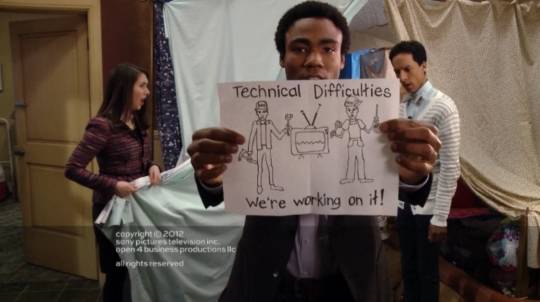
I’d like to post a piece of writing from one of this blog’s fave guests (and humans in general), Dr. Stephanie Hinnershitz; please note that this was originally posted to her personal facebook page, and is shared here with her permission:
There's a reason why historians are moving away from using "internment" when discussing the forced removal of close to 120,000 Japanese Americans during WWII. I also realize that I recently used "internment" in an article I wrote. This was a stylistic choice on behalf of the editors and I should have pushed back more, but it made sense for context and readership. Incarceration is the appropriate term. Here's why:
I received a few private messages and emails from friends and strangers asking if I knew that German Americans and Italian Americans were also interned during WWII. Yes. I am aware of this. Many times, people bring this up in a "gotcha!" way to try and prove the point that the incarceration of Japanese Americans was not racially-motivated or had no racial angle to it at all because if it did, why did close to 15,000 "white" people end up interned? In a more charitable way, people bring up the internment of German and Italian Americans because they did not know about it until well into their adult years and assume that I might not know about it.
But let's return to the internment issue. I study the removal and incarceration of those--foreign and American-born--of Japanese descent. The internment of "enemy aliens" is not my area of specialty. Under American policy, internment during WWII was a specific term for the detention of immigrants who were nationals of enemy nations (Italy and Germany, for example). Now, there were certainly Japanese enemy aliens, but the majority of them were held with other German and Italian enemy aliens in detention centers overseen by the Department of Justice. Internment fell under the DOJ.
The word "internment" doesn't apply to Japanese Americans who were removed from their homes by the Army and then transferred first to "assembly" (detention) centers and later to the "relocation centers" or "camps" (or concentration camps--yes, this phrase was used by many officials in memos and correspondence--prisons, prison camps, etc.). The reason why internment is not the correct term is because the majority of those Japanese Americans who wound up in one of ten prison camps were American citizens, not "aliens." They were not "enemy aliens" because a) they were from America and America was not at war with America and b) they were citizens. Even the planners of incarceration and a lot of the military officials I researched were careful to avoid the term "internment" when discussing the removal and imprisonment of Japanese Americans after Executive Order 9066 because it was basically incorrect. (Side note: Many government and military officials knew that incarcerating American citizens was constitutionally a bad idea and tried to persuade FDR to avoid including Japanese American citizens in enemy alien roundups.)
Because internment was not really applicable to the majority of ethnically Japanese American citizens, the government created a new agency--the War Relocation Authority (WRA)--to oversee the ten prison camps. The Army was supposed to be free of any responsibility once Japanese Americans were transferred to the camps, but--if you read my article--this didn't work out. The WRA a bureaucratic nightmare, a massive waste of taxpayer money, and just a poorly-managed civilian agency tasked with running an unconstitutional program.
Internment of Germans and Italians WAS NOT the same as incarceration of Japanese Americans. Two different programs overseen by different agencies. So, really, there are responsible and interesting ways to place incarceration and internment in conversation, but you can't really responsibly do it if you're trying to say that there were not racial elements to Japanese American incarceration.
BUT--if you want to try and make that argument, here are some other reasons why you're wrong:
1) When you make a decision or policy based on the belief that an entire group of people behave a certain way because of racial characteristics, that's racism. And that's exactly what happened with Japanese American incarceration.
2) Did General John DeWitt (in charge of the military zones along the West Coast where most Japanese Americans lived) believe that ALL enemy aliens should be removed from vulnerable areas regardless of race? Yes. BUT this starts to break down once we get into citizenship...
3) German and Italian Americans (whether foreign or American-born) made up a HUGE portion of the American population, particularly on the East Coast. Initially, government officials thought that even American-born citizens of German and Italian descent should also be removed and incarcerated like Japanese American citizens, BUT Italians and German Americans should be given an opportunity to explain themselves--due process--before a committee. Japanese Americans did not receive this consideration at any point AND the idea of removing and incarcerating German American and Italian American citizens was eventually dropped. Officials argued that it would be impossible to do this because there were so many Italian Americans and German Americans. Also, because many of Italian and German descent were American citizens, they were obviously loyal to the U.S. and we shouldn't really be concerned
....
Wait--what?
I hope after reading that you were able to stop and think, "But I thought you just said the majority of Japanese Americans who ended up in the prison camps were American citizens?"
Yes! I did say that! Please continue reading.
4) Officials determined that Japanese American citizens were less trustworthy than Germans and Italian American citizens because even if ethnically Japanese individuals were born in the United States (and many of those incarcerated were members of the second generation--never been to Japan, went to public schools, had plenty of American-born friends), their parents (immigrants from Japan) were unable to naturalize or become American citizens...BECAUSE RACIST LAWS SAID ASIAN IMMIGRANTS WERE UNABLE TO NATURALIZE. See what's going on here?
5) Okay, so the next "whatboutisms" that usually pop up include planned attacks by Japan coordinated with Japanese Americans in the U.S. and the dual-citizenship of those born in America to Japanese parents. Were there attempts at or completed attacks of the West Coast by Japan? Yes, the "Bombardment of Ellwood" for example. Is there any proof that these were coordinated with the help of Japanese American citizens or even "enemy aliens?" No. Were there Japanese enemy aliens who did suspicious things or expressed anti-American attitudes? Yes--just as there were with German and Italian enemy aliens. But the fact remains that it was predominantly Japanese American CITIZENS with no connections to any subversive plans who ended up in the camps--a significant difference compared to German and Italian Americans.
As for dual citizenship, if you use this argument to justify the incarceration of Japanese Americans, congratulations! You're a bona fide 1920s racist! This is the exact argument used by 1920s racists and there's a grain of truth in there: Because of citizenship laws and negotiations in Japan and the United States, Japanese Americans born to Japanese parents in the United States before 1924 were automatically both citizens of Japan and--because of birthright citizenship under the Fourteenth Amendment--were also U.S. citizens. Officials used this to argue that with dual citizenship, even Japanese Americans born in the U.S. had loyalties to Japan and deserved to be locked up. What this argument did (and does not) take into consideration is the fact that between 1924 and 1940, Nisei (second-generation Japanese Americans) began to renounce their Japanese citizenship--approximately 70% (according to records kept by the WRA and other data). And after 1924, this dual-citizenship situation no longer existed.
6) The end result of this was that the government and the military determined that even Japanese American citizens were less trustworthy simply because they were of Japanese descent. Discrimination and segregation laws along the West Coast made sure that Japanese Americans had a difficult time fully integrating into American society...and then this was used against Japanese Americans to argue that because they remained unintegrated, this meant they were disloyal to the United States! Anti-Japanese sentiment had been building for a long time along the West Coast, and enterprising and racist politicians and farmers who wanted access to Japanese farmland (Japanese were incredibly successful farmers because they took risks and developed different crops in California especially) took advantage of wartime hysteria and lobbied for removal. And it worked.
So what does this all mean? You can't compare Japanese American incarceration to German and Italian enemy alien detention if you're trying to make the argument that there was no racism in incarceration. Some 11,000 German Americans (most enemy aliens) were interned in enemy alien detention camps. As for Italian Americans interned, you'll see the misleading figure of 600,000 Italian Americans interned. This is not true. The government classified 600,000 non-citizen Italian Americans as enemy aliens and they were placed under curfews and other restrictive actions that violated their civil liberties--but 600,000 Italian Americans were not interned. About 10,000 were removed from the West Coast and ultimately under a thousand interned--all enemy aliens, not citizens. Additionally, on Columbus Day in 1942, FDR officially declared Italian Americans no longer enemy aliens (he got a lot of pressure from Italian American Democrats in NY who basically said, "If you want our support for the New Deal, don't even think about it, clown."). Japanese American citizens were removed from their homes, placed in prison camps in terrible areas, and denied due process. People also like to say incarceration was not that bad because Japanese Americans had places to live, the camps provided games and entertainment, and they got to leave to go work by 1943. All true. But many of you can't even wear a goddamn mask without griping, so to say that "it's not a big deal" to have the government remove you from your homes and place you in a desert somewhere is a little disingenuous, no?
And if you're still going to say it's not a big deal--Japanese American citizens also had their guns confiscated. So there's that.
AND here's the best part: About 15 years ago, some members of Congress tried to issue pass legislation to issue a public apology to German Americans interned during WWII and create some required programming in school curriculum to be sure kids learned about this. But you know what? Republicans refused to have anything to do with it because it was "un-American" and unpatriotic.
57 notes
·
View notes
Text
Buffy Season 11: Review
This one was... a lot. I struggle calling it “good”, but more so because generally the media I engage with that I call good gives me happy feelings. This was very low on the happy feelings, but it was intriguing and interesting and... well, a lot.
It was, admittedly, a next logical step. The world knows the supernatural exist. Human-eating monsters exist. Demons are now in the open and work day jobs. Obviously would the internment camps and magic prosecution follow. Humans can’t even handle other humans with differently colored skin, if there’s a five-horned green-skinned demon working at their coffeeshop...?
The story inside the internment camp was intense. But also enjoyable, in that it was a different kind of story for this universe. And seeing Buffy, Willow and Spike going through these struggles, dealing with this directly, first-person was interesting.
I wish they had... leaned more into Willow’s Jewish heritage though, because quite frankly, the fact that the Jewish Wiccan woman ended up in an internment camp in the US for her religion was something that... should have had some actual screen time of thoughts and be brought up more. Sure, she occasionally yelled at the authorities about this being religious persecution but only in the very last issue did someone even put into words that Willow was Jewish and thus familiar with the concept of religious persecution. I really would have liked to see more into Willow’s thoughts - and not just her thoughts about the girl she kind of liked. Or see this angle be more vocal on the outside.
Which, in general, I would have liked to see more of. The story was incredibly centered around the trio of Buffy, Spike and Willow - and that might be my personal favorite combination of Buffyverse characters so this is in no means a complaint about that - but this was such a large scale thing, I would have liked to see the actual scale of it.
One issue, just one additional issue that focuses on giving us other in-universe characters’ perspective of what is happening and their experiences.
Giles got shipped off to boarding school for his own safety, but show me how he’s handling that, both posing as a child and also hiding his magic and supernatural knowledge.
Faith joins the fight at the very end, but how were things in England? We only see the US and how they’re handling it. But is it as bad in England, or is it perhaps better there? Or maybe even worse?And while we’re with Faith, how’s Angel handeling that, depending on how bad the situation in England is?
What about Andrew? He just fled to Italy in hopes it’s better there. Well, is it? Is he worried about his friends? What were his thoughts when he heard about the camp? About that Buffy, Spike and Willow got put into a camp?
Xander and Dawn were only mentioned once quickly during a phonecall, but show me, show me how they were adjusting to this, to the loss of their friends, the hiding. Show me the altercations that Xander got into. Show me the racism against the supernatural that is still happening on the outside.
Harmony fled the country. Did she go somewhere safer? What are her thoughts on this? Where is she? Is it actually better there? Is Clem with her? He’s visually demonic too, how bad is what he’s facing?
What about Satsu who was working with the government last we saw her, but oh boy do I hope that the Japanese-American Slayer quit when there were internment camps in the US. Or Kennedy and her deepscan? And them both learning about Buffy and Willow being in the camp?
Heck, how are things in Tibet? Are Oz and Bay okay? They’re werewolves and there’s a stigma to that. Are they in danger? Are they okay? Are they... considering the magic-removal, since that itself is not a negative thing for everyone, not for those infected with something against their own free will.
And I’m aware that there’s a whole Angel & Faith series and I think that this is where the Giles comic kicks in, but... I’m not even asking for one issue per character, I want one issue of the Buffy comics that shows the perspective of these other Buffyverse characters, particularly ones like Giles who spins off from this very season or Faith who comes back and joins us in the final battle. 28 pages on these 7 POVs would only be four pages per POV and I think it would have done wonders in showing us what the world is like now.
The story is so incredibly limited ot the US that they even kind of conflated the Americas with each other. Andrew immediately talks about leaving for Italy, they consider deporting Spike back to England. What about Mexico and Canada? That seems like a quicker get away. Are you suggesting they got as bad as the US, just because San Francisco was attacked by a dragon?
I think that all of these aspects would have been incredibly interesting.
I’m also undecided on the ending. On her returning the power to the Slayers. Not only are they just... going free? Like, they volunteered as guards in a fucking internment camp, they should be locked away. No, they get their superpowers back, the ones they used to oppress others, because they went teary eyed and promised to never do it again. That was an incredibly, incredibly bad take in a story that was written to mirror WWII. No, don’t give the Nazi soldiers superpowers after you let them get away with a slap on the wrist. What.
So, that’s the verdict. The story that was given was very interesting and I think it was mostly well-written, but I wish they had broadened the scope of it all and shown us more and goodness gracious change that ending.
(Lastly, a shipper note: Spuffy still going strong. Being domestic even in an internment camp. Giving each other strength. Getting each other through this. Buffy not being willing to abandon Spike. The “I love you”s. These comics are positively killing me.)
7 notes
·
View notes
Text
If Bombshells ever returned, maybe to explore the aftereffects of the war. Here are some superheroines and supervillainesses that could join the fight into the new era. The Cold War.
Jesse Quick; Jesse would totally join the families providing their homes to the displaced Jews of Europe while at the same time protecting her city from all sorts of crime. But her storyline might come with learning that in her need to help everyone and solving everyone's problems since she has the technology and the privlege, well... kinda appears as a white savior. At least to Lisa Snart which brings me to...
Golden Glider: Well I think we can all guess that Lisa has a Jewish-like last name and while her big bro, Captain Cold, Leonard was working with the Nazis, I am so arguing that he was just conveinately converting in order to save his skin and his sister's. Anyway with her brother in jail and Europe in shambles after the war, Lisa can travel to America with other displaced Jews. Some families were kind enough to "foster" these peoples which is where Jesse comes in. Well Lisa isn't the type to accept the "pity" and dislikes how priviliged a life, Jesse leads. Then comes a whole new yet classic Flash vs the Rogues rivalry.
Nyssa ah Gul: How can we forget another misplaced Jew. Well not Jew but Ra ah Gul's other daughter, Nyssa, whose entire adopted family died in the concentration camps while Ra was off whatevering with the Lazerus Pit. But since Ra's long gone from the picture, I suppose Nyssa will have to seek answers from Talia about why she didn't try to help her or contact her after finding out they were sisters.
Mya: Meanwhile after WWII, India is revving up for a revolution after being used and abused by the British Empire in a war they didn't even want to be in. And after being in the war, STILL treated like second class citizens. That's why Myra, prodigy of Shiva is up to lead a revolution for her people.
Gypsy: Let’s not forget about all the other groups that Nazis were prejudiced against. Cynthia Reynolds or "Gypsy" as the SS slurred against her and her Romanian family. But with Europe's landscape in disarray, Cynthia can use her earth-bending powers to help and educate people that she is more than the fortune telling, pick pocketing stereotype that the world believes.
Volcana: Now I know we didn't really get into Italy's part in WWII, but someone with volcano powers would totally be working in Italy, specifically Pompeii. The one issue is that, like in her origin story, she was working for Mussolini against her will and the Italian still wants their "super weapon" under lock and key in case of WWIII.
Thorn: Meanwhile the late 40s-early 50s is totally not a time to be woman with a mental illness. Especially when the "understanding" doctors try to lobtomize you. So Roselyn Forrest's double personality disorder is a big problem in her life. Especially since her second personality is a scythe weilding maniac and her uncle wants to put her in an institution. Added to the fact that she is still suffering under Irish discrimination. Hopefully the Batgirls can help, not only change child labor laws, but views on mental illness too.
Giganta: A gorilla turned into a girl. Why shouldn't that be an experiment by the crazy Americans or Russians in a way to beat each other as the world superpower. Well technically the Russians wanted to send a gorilla into space and beat the Americans, but they thought a woman astronaut (or as they called cosmonaut) would make them look better. (All true look up Valentina , first woman in space). But besides being part of the space race, Giganta can bring spotlight to Africa where she was born, and which is being divided by the major world powers for exploitation.
Crimson Fox: Constance D' Amis, French heiress would be part of the small army of woman workers during the YALTA conferance trying to get their say into how to rebuild Europe for the benefit of all. Who knows, maybe she even talked to Selina Delgatti. Hey French heiresses and Italian heiresses must know each other. Plus she expels hormones that can make anyone under her thrall which leads me to...
Queen Bee: Another pheromone expelling woman. A villainess though. Africa wasn't the only one being exploited and colonized. The former Ottoman Empire was being exploited for its oil and Lebenon is taken over by the French (Basically ample reason for Constance to go to Lebenon and fight Queen Bee). And the former queen is certainly not above going to the Russians to fight the US/Europe to get her country back. Or just team up with Lex Luthor to take down Supergirl and get her country back. I just imagine Lex and --- to be like an evil Mr.Darcy and Elizabeth Bennet okay. All suave, witty banter. It makes sense in my head.
Catherine Colbert: A bit like Lois Lane, Catherine is an everygirl. Well if the everygirl was a daughter of an dimplomat and had her sights on making a name for herself in NASA and trying to avoid the pressures of mysgonistic men that woman aren't fit for government. Being told that she is too emotional and should stay in the kicthen, Catherine rebelled by becoming a stone faced, cutting ice queen in the diplomacy track and also a horrible cook.
Artemis and Cheshire: I'm taking a bit from the YJ story in that Artemis and Cheshire are half-french, half-Vietnamese. Since their abusive father was loyal to the Nazis, he disowned them and cast off their Vietnamese mother in Japanese concentration camps. While Artemis made it to America and tried to stay on the good ol American democratic way (while fighting petty looters in the streets of Gotham as one does), Cheshire went to Vietnam where she works as an assasin, for the communists and the non-communists. It doesn't matter to her as long as she gets paid. But times are changing in Vietnam as the fights about communism between the North Vietnamese and South escalate.
Lady Blackhawk: Zinda Blake, hero of WWII and the Blackhawk brigade comes home to nothing. No money. No pension. No respect. Life as a veteran has no perks since no one has money to pay in Europe. Plus she'd still be trying to adjust to civilian life after nonstop combat and the inevitable PTSD while the Germany she loved is split into two. Hopefully Rudi and Helen will help to keep her in a safe place until she can get back on her feet.
Miss Martian: While I don't know whose in Harley, Ivy and Viktoria's circus, I feel like Miss Martian would find a safe haven there. While she did not experience the WWII, she did experience a similar prejudice and genocide on Mars being a white martian so I bet she can help with reprations. Or just join Starfire on the fire squad...wait nevermind. Fire is Martian weakness. Well at least have her and Starfire being alien girlfriends exploring the strange Earth world together.
Rocket: Again, haven't had the joy of reading the final vol of Bombshells United so I don't know exactly what Bumblebee has been up to nor the racism she had probably experienced. But Raquel would be in a similar boat. An African American teen in an unjust pre-Civil Rights movement society with the added difficulties of teen mom hood. I really want some spotlight on her whether she joins the Batgirls or strike out on her own or helps Icon just like in the comics.
Mercy Graves: Alongside Lex wherever he is, I want a similar debut to what Mercy did in JL. Mercy takes over LexCorps during Luthor's absence, absolutely crushes it and makes it more of a success than Luthor ever did because she is not obsessed with the Kryptonian heroes. Maybe she even teams up with Waller? Who knows? Or even have two heads, Mercy Graves and Lena Luthor, making millions and making plans, evil or no, always ending on top.
Silver Banshee: A woman whose screams causes people to age. How they could NOT use her in a war, I do not know. But I picture Siobhan's arc going something like after her family dies in battle or something or other, she taps into her genetic banshee powers. Fueled with grief/cynicsm/vengeance she travels around the Iron Curtain, causing death since death is a mercy compared to living in destitute misery.
Plastique and Roxy Rocket: One is a Canadian explosives expert, another just really, really loves rockets. Both would be very useful on either side of the Cold War. They're traditionally illanesses so I could see them as double agents like Cheshire, working for whoever pays the most for their time.
Roulette: Roulette’s big thing is gambling on illegal cage fighting activities. Well lets up the ante by having her big gamble being stoking US/Russian tensions. After all the longer the war goes on, the more she gets paid for her information on the other side, her contacts for weapons, her spies etc. She'd be rolling in dough, and loving it even when under threat of nuclear destruction.
Fire and Ice: No idea how the heck they would fit in to a post WWII world. But let's suppose they want to escape Brazil and Antartica respectively to be able to help out in the aftermath after doing nothing during the war.
Jessica Cruz and Aresia vs Star Sapphire Meanwhile with Hal Jordan out of the picture, let's have the infamous Green Lantern vs Star Sapphire rivalry again.
Lady Shiva: Street fighter, assassin, mother of the future Batwoman, Cassandra Cain. Lady Shiva must be part of the Cold War. She is bit of a anti-hero so I doubt anyone would know where her loyalties truly lie, but she'd be on the side of whoever her daughter wishes to protect.
Cassandra Cain: The new Black Bat, continue Katy Kane's work, and the Batgirl's work, and all the work that needs to be done after WWII. She's the new heroine.
#dc comic bombshells#dc bombshells#golden glider#lisa snart#nyssa ah gul#mya#jesse quick#cassandra cain#black bat#lady shiva#cynthia reynolds#gypsy#claire selton#roxy rocket#volcana#jessica cruz#green lantern#carol ferris#star sapphire#fire#ice#roulette#cheshire#artemis#plastique#silver banshee#mercy graves#miss martian#rocket#catherine colbert
25 notes
·
View notes
Photo

Are you a polyglot? @queenhorsfall is! 🗣️ I like to learn words in other languages but like many Americans, I can only speak English. 🇺🇸 I’m a third-generation Japanese American (sansei) & have lived in Seattle for six decades.🌲 Most of the Japanese I learned were niceties to say to my grandparents, 👴👵 but as a kid, I also picked up essential words like “baka” (idiot) & “hanakuso” (booger). 👃 This week I learned “Shikata ga nai,” means, “It can’t be helped.” Podcast host @GuyKawasaki described it another way: “It is what it is, so stop feeling sorry for yourself & suck it up.” 😢 Guy did a podcast 🙉 with Jeanne Wakatsuki, the author of a memoir, Farewell to Manzanar. 📙 Manzanar was one of 10 camps built to corral Japanese Americans during WWII. 😱 In his prologue, Guy says Jeanne has traveled to educate people with the hope that nothing like this happens again. I hope that, too. ⚠️ The Japanese attack on Pearl Harbor led the US to enact #ExecutiveOrder9066 to stop espionage. 🕵️♂️ Fear, suspicion, & war hysteria led to the three-year incarceration of more than 120,000 Japanese American citizens. 🎌 During the war, my family 👨👩👦👦 was dispatched to a concentration camp at Tule Lake in northern California. ☀️ It’s the Japanese way to quietly endure & overcome. 🤫 My bestie & I (both sansei) have talked about how the camp experience did a real psychological number on our parents. 🧳 Can you imagine in current times 🚔 locking up people because of their ethnicity or beliefs? 🤔 How about their medical status? . . I discovered the #RemarkablePeople podcast 👂 through my professor @erickoester. Guy has fascinating conversations with interesting people—remarkable people, actually 🙂. I hope you’ll check out & subscribe to his podcast. The link is in my bio. . . Family update: oldest son arrived home safely! Photos: #roses #hydrangea #chrysanthemum #funeralflowers #godspeed #summercolors #summerflowers🌸 from #Charmaine&Bill #pixelphotos #googlepixel #Seattlesummer #Seattleinthesummer # #macro_delight #japanesewords . . . (at Madrona) https://www.instagram.com/p/CR-3fCbrB9M/?utm_medium=tumblr
#executiveorder9066#remarkablepeople#roses#hydrangea#chrysanthemum#funeralflowers#godspeed#summercolors#summerflowers🌸#charmaine#pixelphotos#googlepixel#seattlesummer#seattleinthesummer#macro_delight#japanesewords
1 note
·
View note
Note
Genuine question. I am a history grad student specializing in the Cold War. I have a hundred years of evidence of all kinds from four continents that indicates that socialism ends with mass graves and prison camps. What makes your guy different? I figure you probably won't publish this because it runs counter to your bought and paid for purpose, but it would be braver if yoou did.
Ah, so from your studies, you probably read that only one long-lasting democracy has ever existed...the US. Suggesting that democracy is somehow the perfect political system is entirely short-sighted. All political systems have flaws.
Speaking of flaws, I’m glad you brought up “mass graves and prison camps” - two things the US is notorious for. I’m sure you’ve read how the US has the highest incarceration rate in the world. No? Then perhaps you recall when the US created concentration camps for Japanese Americans during WWII, yes? Maybe you also missed children being locked in cages at the border. Oh, and remember learning how the US has incited, enabled, and participated in wars all across the globe? How ‘bout that for mass graves.
You asked me, “What makes you guys different?” Simple - I know what the hell I’m talking about. Now get off my blog.
#politics#asks#us politics#socialism#democracy#government#history#end mass encarceration#end all wars
114 notes
·
View notes
Text
“They Called Us Enemy”: George Takei Recalls Interment and Its Cautionary History
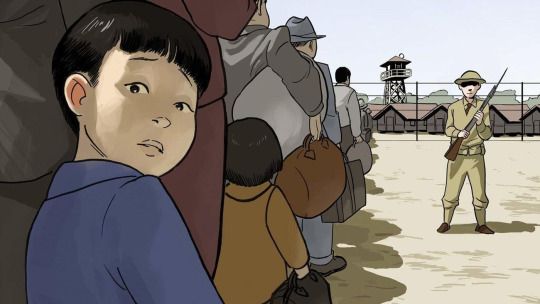
Written by George Takei, Justin Eisinger, Steven Scott
Illustrated by Harmony Becker
This past weekend I got to make my annual pilgrimage to the nerd Mecca capital of the world; San Diego Comic-Con.
It’s a fun and often exhausting experience between panel hopping to see your favorite movie or TV show actors speak and standing in line often for hours just to see them or to buy merch in the Dealer’s hall.

(At least it wasn’t hot this year.)
Every year though, somehow or another, I always meet at least one celebrity be it intentionally or accidentally. Last year I got to run into Billy West, best known for his voice acting roles on Ren &Stimpy and Futurama, the year before that it was MMA legend Josh Barnett who is a huge comic book geek and before that I met my all-time favorite TV composer Bear McCreary. This year I got to not only meet, but cross a massive name off my bucket list, in George Takei.

(^It me...)
Takei needs no introduction of course; the outspoken OG Star Trek alum is now firmly an internet personality of sorts and hugely popular figure amongst my generation and nerdom alike. But he wasn’t there at Comic-Con to talk about Star Trek or any number of Science Fiction related items to his acting past. No, this time he was here to promote his new graphic novel “They Called Us Enemy” based on a much darker period in his life; the infamous internment of Japanese Americans in concentration camps across the country during World War II.
Takei has never been shy about his opinions on politics and society and definitely very open about his time in those camps but this graphic novel helps not only shed a light on his own personal experience there and all the nuanced feelings that came from that but just how deplorable Executive Order 9066 was on American History.
Now, with the recreation of concentration camps this time along the southern border indefinitely imprisoning migrants seeking asylum in our country, Takei’s graphic novel reminds us all why this is so wrong and why we should not turn our backs again.
“They Called Us Enemy” is one-part history book detailing key events, people and often distressing quotes from our politicians on Japanese-American concentration camps but three-parts a visual and written history of Takei’s family journey from pre-WWII internment to the present. Through his parents, his father a first generation Japanese American, his mother second generation to how the events of Pearl Harbor unlawfully stripped them of their dignity, they try their best to make sense of the situation while keeping their children from baring the weight of this shameful period of history. What is an “extended vacation” for Takei and his siblings is a prolonged agonizing experience of doubt, humiliation and degradation for his parents and the toll it takes on his father especially is told through the panels of this graphic novel.
I think the most astounding thing about this graphic novel is that it isn’t especially bitter. It’s upsetting for sure, and bitter in parts, as Takei certainly wants his reader to feel how his family felt through this period in American history but he makes a point of showing how inevitably in all things in America, the wheels of justice may be slow but they do not stop moving forward as long as there are those willing to fight for it. How Takei’s family handles this humiliating and degrading experience is both brave and sad all at once. Takei, for his and his younger siblings, part are completely ignorant of the situation they’ve been forced into and his parents do their best to keep things as normal as possible for them through this ordeal treating it as a long “vacation” for them. They do this despite the fact they’ve been forcibly torn away from their homes, given no time to pack their things, given nametags like cattle and forced to sleep and live in conditions befitting of farm animals.
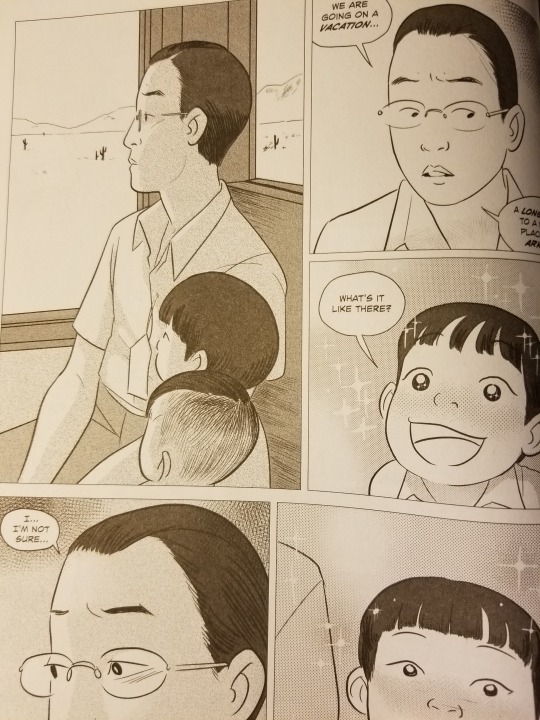
America may not have led anyone into death camps, during this period, as the Germans did with the Jews but as Takei points out it was still based on fear of a perceived “enemy” and still forced Japanese Americans into these horrid conditions and to do things that our constitution and Bill of Rights explicitly states against for its citizens.
But for Takei, as a child back then, it was an adventure of sorts for he and his siblings that was shielded by his parents to keep him from grasping the full scope of what was really going on. In this way, the graphic novel is somewhat bittersweet; sweet that George and his siblings through the tireless effort of their parents was able to enjoy some level of a childhood within the camps but bitter that as he grew older he finally understood why he was there.
Through Takei’s writings and Harmony becker’s wonderful illustrations we get a grasp of the simultaneous joy and pain that Takei associates with this period in his life; how his mom, when given little time to grab her own personal belongings when the soldiers came, grabbed only things for her children such as sweets and a sewing machine to fashion them new clothes in the camps as to keep their childhoods alive, and how his father helped organize camp leadership and helped lead these disillusioned Americans who had no idea what the future held or if there was a future there at all.

It was in these camps in fact that Takei discovered his love for acting and theater, as funny as that may sound, as camp members were able to show movies within its barb-wired fences. Takei would use this inspiration when his family returned to Los Angeles to become an actor down the line and eventually take up his famous role as Sulu in “Star Trek” and the reason largely was because of the camps. As the graphic novel states Gene Rodenberry (Star Trek’s original creator) wanted a show that envisioned a future where a diverse cast of people worked together for the benefit of all humanity and having an Asian American not only be present in this cast but be a resourceful, responsible lead was paramount. Takei understanding how taking on a role that could give Asian Americans agency in popular media wanted the part immediately as it could help show the country that people who looked like him weren’t the enemy.
Fifty plus years later and he is still advocating for that representation and need for diversity today.

(Being God damn fabulous at it too)
The graphic novel does lay out many things that most average Americans are probably not familiar with; the fact that much of these Japanese-Americans belongings were liquefied and sold off after they were taken from their homes, that many of them tried to join the fight against Japan after Pearl Harbor but were turned away because of their race, and of course after the US finally needed more troops they conscripted members of these very same camps, people they had openly vilified and wrongly detained, to enlist later to become the 442nd Battalion the most decorated group of its kind during World War II.
It’s again infuriating and uplifting all at once; as Takei points out the people who chose to enlist from the camps were as much patriots and heroes as those who chose not to and who could blame them? Many Japanese Americans saw it as an opportunity to prove they were indeed Americans and show the country that had wronged them that they were as patriotic as their white counterparts. For the others it was an act of civil disobedience showing that they didn’t need prove anything to the country that had turned their backs on them.
Takei’s family chose the latter in this regard and nearly lost everything in the process.

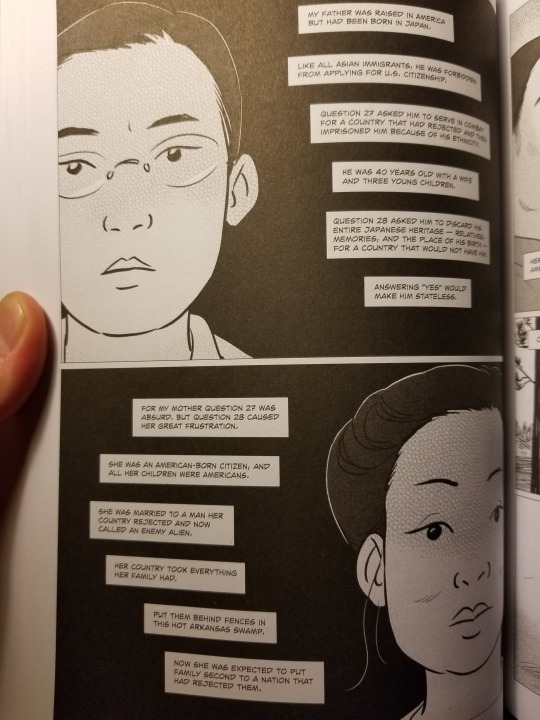
The path toward justice is often a long and degrading road for victims and the unjustly accused. For Japanese Americans during this time it took damn near half a century before reparations were made and by then many of its oldest prisoners had passed away not knowing that America had admitted their guilt.
Its sad and if reading about this part of history and seeing what’s happening now at the border doesn’t make your blood boil, I’m not sure what will.

“They Call Us Enemy” does a great job of not only informing Americans on what happened during this time period and Takei’s very personal story in between all that, but offers a stark warning about repeating the mistakes of the past as we are now at the border. We cannot keep going with this cycle of endlessly vilifying folks for simply looking the part of “the enemy” regardless of their legal status or us being at war with countries that happen to look like them.
I’m of the mind that people deserve inalienable rights regardless of citizenry. Locking up people and throwing away the key indefinitely and ripping children from the arms of their screaming mothers (Something we didn’t even do to Japanese Americans) without trial is FUCKING WRONG PERIOD and ill-befitting of country that self-labels itself as the “greatest” on Earth.

If we are to pretend we are the good guys in any of these types of conflicts we better start acting like it. FUCKING NAZIS in Nuremberg were given trials after World War II; you cannot tell me an “illegal” doesn’t deserve a chance at a hearing.
I’m often very angry and bitter about the state of the country these days and where we appear to be trending as a society but Takei’s book is not all doom in gloom when it comes to its warning on where we currently stand on justice. As the graphic novel states:

Our strength as a country is that we are capable of change, we are capable of becoming the pillars of democracy and justice that we profess to be through the valiant efforts of those who fight for it. Whether it was the Abolitionists of the Civil War period, Martin Luther King during the Civil Rights era or for these wrongly interred folks, Fred Korematsu, Yuri Kochiyama, Wayne Collins, or Daniel K. Inouye, we will always find a way to move forward as long as brave individuals come together to fight for what’s right.
We can be those brave individuals too, so long as we stand up, voice our disapproval and move the needle of our democracy. We still have all the power here to affect change. We cannot let the wrongs of the past continue on in our present, our democracy and the very fabric of decency, respect, and justice depend on it. Takei’s family and 120,000 plus Japanese Americans who suffered through this depend on us being better for the present and future.
Don’t turn your back on it. Not now, not ever.
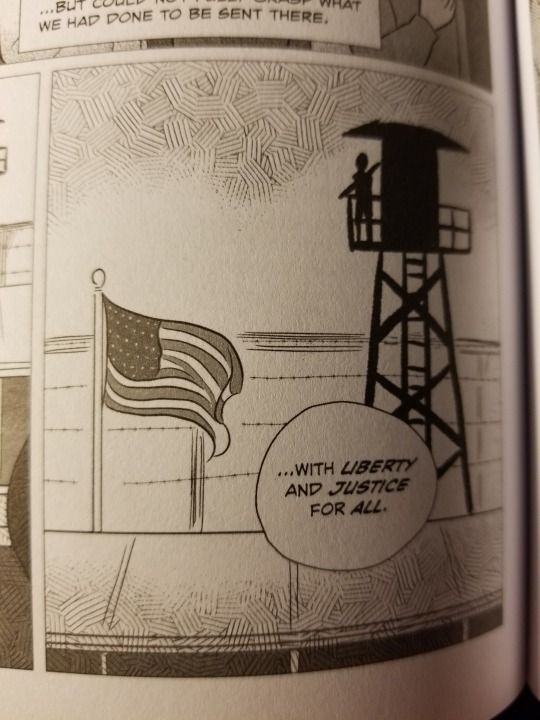
#they called us enemy#George Takei#japanese internment#internment camps#Star Trek#The Terror#Sulu#Graphic novel#comics#comic#comic books#reading#politics#border#social justice#Fred Korematsu#World War II#WWII#asian americans#asian#Americans#Japanese#Japan#Japanese American#The Farewell#crazy rich asians
598 notes
·
View notes
Text
Ghosts of Segregation, the Vestigial Architecture of America's Racism
Ghosts of Segregation is a project by photographer Rich Frishman with the goal of documenting the "the vestiges of America's racism evident in the built environment, hidden in plain sight: Schools for 'colored' children, theatre entrances and restrooms for 'colored people,' lynching sites, juke joints, jails, hotels and bus stations." The top photo above is of a segregation wall in a restaurant in Texas photographed in 2017:
This partition was constructed in the early 20th Century to keep people of different races apart. It is decorated with an original pre-1929 Dr. Pepper logo. At the time of its construction (circa 1906) only Caucasian customers were allowed to sit in the front of the saloon. All Hispanic, Asian and African-American customers had to sit behind the wall. When the saloon was remodeled and re-opened in 2014 the wall, no longer used for its original purpose, was retained as a historical reminder. It has recently been demolished.
The bottom photo shows the "colored entrance" for a movie theater in Texas:
The enigmatic door atop the stairway on the south side of the Texan Theater, long locked and largely overlooked, is the "colored entrance," a vestige of Jim Crow-era segregation. In Kilgore, Texas, the term "colored" extended to anyone not Caucasian, including Hispanics and the occasional Asian.
Also included in the project are photos of WWII internment camps (where persons of Japanese ancestry were held during WWII, many of them American citizens), the US/Mexico border wall, and the Stonewall Inn in NYC. You can see the full gallery here.
3 notes
·
View notes
Text
Jewish human rights scholar: yes, America has built concentration camps
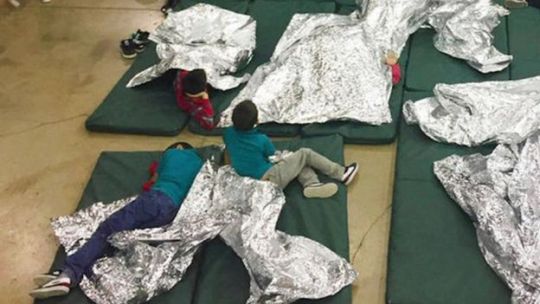
Anna Lind-Guzik ("a writer, attorney, and scholar of Soviet history, international law, and human rights, with degrees from Duke University, Harvard Law School, and Princeton") has written an essay defending Alexandria Ocasio-Cortez's use of the term "concentration camps" to describe the facilities in which America has imprisoned brown-skinned asylum seekers who have presented themselves at the nation's border.
Lind-Guzik -- who is Jewish -- points out that the term "concentration camp" predates the Holocaust, and that the US refered to the internment camps where it illegally imprisoned Japanese Americans during WWII as concentration camps. There's no question that as a matter of linguistics, "concentration camp" is the right word for what the US is doing on its border.
More pointedly, Lind-Guzik defends comparisons to the Holocaust, because "the lessons of the Holocaust will be lost if we refuse to engage with them...Locking up refugees in camps is the real betrayal of the legacy of the Holocaust... 'Never again' means we must work to deescalate before atrocities rise to the horrors of Auschwitz."
She closes with this: "In memory of the 6 million Jews who perished because they were considered less human, I will not accept my government treating migrants like animals. And as the daughter of a Soviet Jewish refugee, I will not accept the criminalization of stateless people."
I'm also the son of a Soviet Jewish refugee, and I agree. What's more, as a "white-passing" Jew, I've watched with increasing unease as my fellow Ashkenazis have thrown their lot in with white supremacy, making common cause with white supremacists who support apartheid in Israel as part of a deranged end-times prophecy (liberally salted with racism and Islamophobia) and with white supremacists in the GOP who defend white privilege with every weapon at their disposal.
When my father arrived in Canada as a child, he was racialized, subjected to anti-Semitic slurs, discrimination and violence. By the time I was born, no one cared -- or even knew -- that I was Jewish. I had been pulled over the gunwales and given a cabin aboard the SS Whiteness.
But the last people welcomed into the boat are always the first people tossed overboard. If there was ever any doubt that Jews' whiteness was contingent and temporary, it should have been erased when Civil War larpers marched through the streets of Charlottesville, chanting "Jews will not replace us."
The alliance of American oligarchs with white supremacists that controls the White House and the Senate is the real threat to us Jews -- not the BDS movement, which seeks to end injustice and halt a vast, wicked program of racist discrimination and militarized violence. The fact that some Jews are on the side of white supremacy does not mean that white supremacist will be on the side of Jews."First they came for the Central Americans" (and I said nothing because I thought racists wouldn't turn on me next).
America has built concentration camps and put innocent people in them. Some of them have already died and more will die in the days and weeks to come. If "never again" ever meant anything, it meant this: Jews must take a stand and say, "Not in our name. Never again. Not here, not anywhere, not ever."
https://boingboing.net/2019/06/21/1-they-came-for-the-mexicans.html
482 notes
·
View notes
Photo




They Called Us Enemy by George Takei, Justin Eisinger, and Steven Scott. Art by Harmony Becker. Top Shelf, 2019. 9781603094504. 208pp.
Takei's memoir about being interned with his family as a young boy, during World War II, and its aftermath, opens with him and his brother being awoken by their parents and told to get dressed. Soldiers enforcing Executive Order 9066 have arrived to take them away. It's upsetting and powerful. Flash forward to Takei's TED talk in Kyoto in 2014, and then the story of his parents and his own birth, Japan's unexpected attack on Pearl Harbor and the US reaction to it -- a history lesson that includes includes "Lock up the Japs" as a popular political position. Most of the rest of the book tells the story of the Takei family's forced relocations and incarceration beginning in Spring 1942 at Santa Anita Racetrack, Camp Rohwer in Arkansas, and Camp Tule Lake in northern California. The details about crowding and conditions are pitch perfect alongside with some funny moments of Takei and his siblings being kids and misbehaving and playing even in those difficult circumstances. I think kids will find these bits very readable, while I found myself identifying with his parents who were trying to do the best for their kids despite where they were. After WWII, they return to Los Angeles, and are forced to rebuild their lives while living on skid row. As Takei begins attending school he sees that racism against Japanese Americans continues (he has to deal with it in his classroom), and he comes to understand that the camps he lived in were like jail. A quick 30 pages at the end brings Takei's story up to date as he begins acting and supporting civil rights, the government apology to Japanese Americans for their internment, and recent court cases that affect immigrants and those traveling to the US.
Worth noting: The art is black and white with a lot of digital textures, and the panel layouts are fairly simple. Along with the young Takei looking out from the cover, these work together to make this a book almost anyone will enjoy, though kids will take more of an interest in the pages about Takei's incarceration as a young boy.
111 notes
·
View notes
Text
Review of Netflix's ‘The Liberator’

So, the internet’s been abuzz with Netflix’s new series, “The Liberator.” I was excited, as well, as it followed the story of a US Army infantry division in the Second World War. It was a great idea. We’ve seen everyone else get their due - Band of Brothers, Saving Private Ryan, Red Tails, The Pacific, Fury - the list goes on and on. But the regular leg infantry really hasn’t gotten their screen time.
I, therefore, sat down late last week and watched the entirely binge-able 4-episode miniseries. They’re about an hour each, and the animation was an interesting twist. It took some getting used to, but with things like anime and graphic novels being big with younger generations, I think this was a good series to introduce younger viewers to a “dogface’s” view of the Second World War.
I also liked the division they picked. The 45th Infantry Division was part of the Oklahoma National Guard, and as Mike Rowe put it, the makeup of the division was “…at first Mexicans, Native Americans, and Cowboys.” What they didn’t mention, but perhaps should have, was as the war went on, and more and more draftees filled the ranks of the US Army, the National Guard divisions like the 45th lost their regional character. It’s a small thing, but I think they demonstrated it with Vaccaro, the character who shows up in episode 3 from Chicago, but it could have been illustrated better.
Overall, that seems to be the tone of the series. A for effort, C for results. The show could have used the help of someone like Dale Dye. First off, the rank insignia on the front of the helmets would have been gone by the time the 45th as a whole hit Italy. Those rank insignia make great aiming points for German snipers! Most units in the ETO went with a bar system to the rear of the helmet, a horizontal white bar for NCOs, and a vertical white bar for officers.
youtube
I was a little skeptical of the main character being as far forward as he was as even a company commander. I get story demands, but I really wish they’d centered the story around the Native American NCO. I get it. He didn’t write the book that the series is based on, but when you have a major acting like he’s a second lieutenant, my ability to stretch reality is a bit strained.
At times, I thought the terminology was made-up because the writers didn’t know the real terminology. The MP scene at Anzio had me cringing, not to mention the German assault during the episode. It more resembled a human wave assault you’d see from the Japanese or the Russians, and not the fire and movement we’d see from a German-style assault. I also didn’t see any German machine guns till the third episode. And every German soldier, with the exception of one (the German Major in the Anzio episode) was SS, which makes me wonder an aside? Why is every German in a WWII movie a member of the Waffen-SS? It’s a pet peeve of mine. And then there was the 60mm mortar killing a tank. Trust me, it’s not going to happen.
That’s not to say there were not elements I did like. I thought the episode with Aschaffenburg and Dachau (especially the gruesome beginning) was very well done (things like that happened as Germany collapsed at the end of the war). The scene in the coal yard at Dachau - it actually happened.
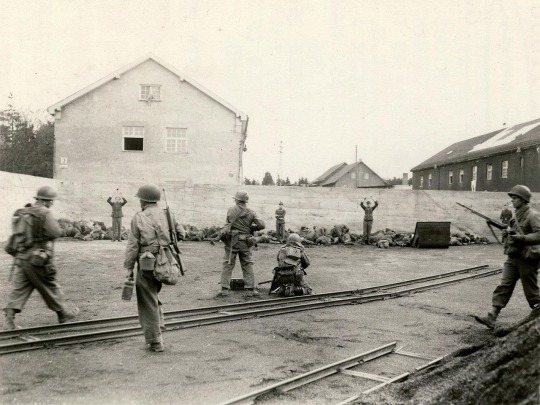
They did a good job of showing not just the incident but the aftermath, and yes, Patton was rather sanguine about it. As he was the military governor of Bavaria, he chose to dismiss it, and yes, our character, Felix Sparks was almost court-martialed, as the show demonstrates. But again, I felt the story was a bit rushed and didn’t explain as well as they should have the true revulsion of the troops involved.
My own Grandfather’s division, the 4th Armored, liberated Ohrdruf Concentration Camp, was part of Buchenwald. The sight was, to say the least, ghastly, and I won’t go into details here. What I will say is I asked him about this photo and incident once. He said to me simply, “Jay boy, we weren’t that dumb. We simply gave the prisoners lead pipes, locked the SS guards in a room with them…and whatever happened…happened.”
I think Netflix overall made a good effort, but the series was too short, and there were more than a few details that could have been done better. All in all, I don’t think the audience for this show is those of us who know and study World War II, but the younger generations who didn’t know veterans of the conflict. I think for them, this is a worthy thing to watch. Still, I’d also have them read books like Beyond the Beachhead, Patton’s Vanguard (admittedly, this one is a view of an entire armored division, rather than an infantry division like the 45th, but the writing is solid), and When the Odds Were Even.
My main complaint: The series needed four more episodes to do itself right. I just felt the story was too rushed and too choppy at times. I get a lot of the constraints, but I am always of the opinion, “if you’re going to tell a story like this, tell it right.” I think Netflix missed an opportunity here, with an innovative medium, no less. I am hoping someone takes up the baton and gives both the tech and the subject manner the respect they deserve.
--
At SJR Research, we specialize in creating compelling narratives and provide research to give your game the kind of details that engage your players and create a resonant world they want to spend time in. If you are interested in learning more about our gaming research services, you can browse SJR Research’s service on our site at SJR Research.
--
(This article is credited to Jason Weiser. Jason is a long-time wargamer with published works in the Journal of the Society of Twentieth Century Wargamers; Miniature Wargames Magazine; and Wargames, Strategy, and Soldier.)
1 note
·
View note
Text
Okay, so regarding the people who are suggesting that it’s hyperbolic, alarmist, or even antisemetic to refer to ICE’s detention centers as concentration camps: the term “concentration camp” predates the Holocaust by more than 50 years. It was originally used to refer to camps set up by the Spanish military to imprison Cuban civilians during the Ten Years’ War. Arguably, the very first concentration camps in history were created even earlier than that, established in the 1830s by - you guessed it - the good old United States to detain Native Americans.
It’s pretty straightforwardly the semantically and historically accurate term to use to refer to what ICE is doing right now. I personally happen to have ancestors who were murdered by the Nazis; I would never say “this is exactly like the Holocaust” or something similarly asinine - I’m drawing parallels to America’s long history of repeatedly doing this kind of thing e.g. the aforementioned Native American concentration camps, the ones set up during the Philippine-American War, the forcible internment of over a hundred thousand Japanese Americans during WWII, etc. So anyway, I’d argue that locking children in literal cages because of their race constitutes a serious enough situation to warrant calling it what it is, instead of using euphemisms and the like.
309 notes
·
View notes
Text
Marvel Cinematic Universe: Captain America: The First Avenger (2011)
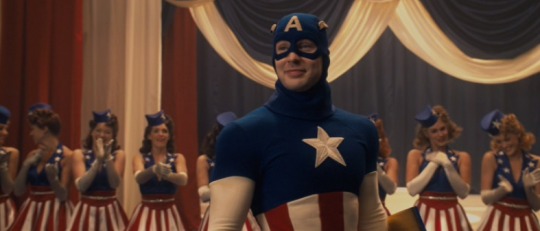
Does it pass the Bechdel Test?
No.
How many female characters (with names and lines) are there?
One (7.69% of cast).
How many male characters (with names and lines) are there?
Twelve.
Positive Content Rating:
Three.
General Film Quality:
Excellent! Full of as much heart as action, the film takes on the complicated task of delivering a Captain America for the modern world, avoiding jingoism while also acknowledging the origins which brought the comic-book hero into being. Against the odds (and my personal expectations), it is a sound success, and I consider it easily the best of the Marvel franchise’s early films.
MORE INFO (and potential spoilers) UNDER THE CUT:
Passing the Bechdel:
Obviously, that didn’t happen.
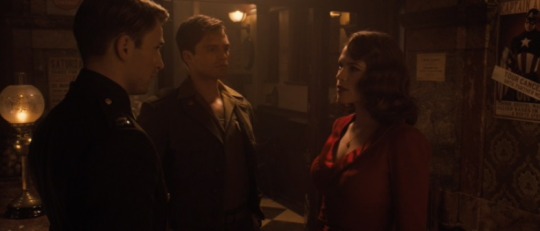
Female characters:
Peggy Carter.
Male characters:
Johann Schmidt.
Steve Rogers.
James ‘Bucky’ Barnes.
Howard Stark.
Abraham Erskine.
Arnim Zola.
Gilmore Hodge.
Chester Phillips.
Brandt.
Fred Clemson.
Timothy Dugan.
Nick Fury.
OTHER NOTES:
I’m mad about the Hydra symbol being the coolest insignia in this franchise. I would wear the heck outta some Hydra merchandise, if it weren’t for the, y’know, evil Nazi fascism stuff.
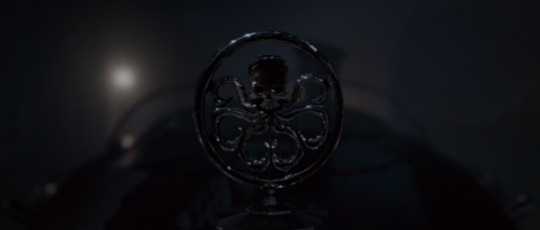
I love little Steve. They pulled that off so well.
I don’t love that Peggy’s introduction revolves around her being disrespected by a guy and then knocking him on his ass. It feels far too prescribed, too Strong Woman Cliche, so expected as to be rendered essentially meaningless. It implies that these are the most important things about the character - she’s a woman and she’s tough - and it panders to the sexist perspective by requiring Peggy to ‘prove herself’ upon arrival in a traditionally-masculinised way. They could have handled this introduction much better.
Man. This movie has such a good cast. The goodness of this cast has no chill.
“So many people forget that the first country that the Nazis invaded was their own.” This the good shit.
“Go get him! I can swim.” Snort.
Sometimes, when I can’t sleep, ‘Star Spangled Man’ plays over and over again in my head. That’s probably why I can’t sleep.
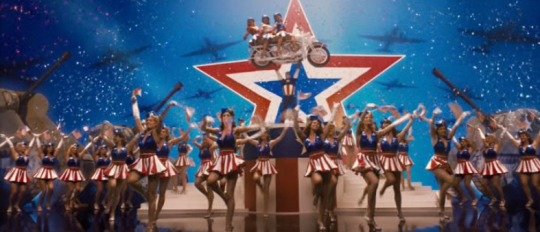
“Do you...fondue?”
The thing where someone gets hit and they fly off-screen in an exaggerated fashion is never not funny to me.
Characters surviving explosions without a scratch, however, is never not rubbish to me.
A super-soldier is never late, Peggy Carter, nor is he early; he arrives precisely when he means to.
Steve really isn’t very precious about choosing his team: they’re all just Bucky’s friends. He basically just went “ok, show of hands, who loves Bucky Barnes? Good, you guys are with me”. I mean, it’s solid reasoning - he trusts Bucky, and these guys have Bucky’s endorsement, and that’s good enough for Steve. I note that only one of the other guys on the team besides Steve and Bucky is a white American - the other guys are a black American and an Asian-American (and I see you there, recognition of racism against Japanese-Americans which led to their incarceration during the war, etc.), and then there’s a French dude and a Brit. That’s Captain America’s elite team: not all-American, and racially inclusive. I DIG that subtext.
*hisses* why is this whole Natalie-Dormer-mackin’-on-Steve thing even here? It’s a useless contrivance, plus I am extremely displeased at having Peggy being so petty in her jealousy that she actually fires a loaded gun straight at Steve. I sure hope she heard Howard’s explanation about the properties of the vibranium shield, or that she already knew them, because otherwise this is completely outrageous, but even then: what if the shield hadn’t performed as advertised? What if a bullet ricocheted and hit someone else? This is such a dangerous thing to do, and did I mention it is in service of a useless contrivance anyway? Peggy deserves better writing.

Lemme tell ya straight up: I thought I was gonna hate this movie. I mean...it’s Captain America. I expected cloying patriotism, a blandly self-righteous hero, probably some good ol’ war glorification as well. What we got instead was a film that barely even mentioned the good ol’ USA outside of the (explicitly recognised as) propaganda rigmarole that Captain America slogs through - a tool used to excellent effect to acknowledge the character’s history (the comic was created as propaganda during WWII in real life) while also carrying through the idea that what Captain America stands for is something far grander than nationalist fervour - and Steve himself is imbued with unassuming charm, fueled by the strength of his personal convictions but never forcing those convictions upon others in a show of moral grand-standing: an essential facet of the character is that he’ll pursue what he believes to be right regardless of whether anyone else follows him, and he accepts that there are consequences to his actions; he never props himself up with holier-than-thou declarations, he never shames anyone for disagreeing with him, and he never claims any kind of superiority over others (an important distinction when you’re juxtaposed with a Nazi Ubermensch villain). Other characters are inspired by Steve, but the film wisely never positions them as if they were weak or wavering without the symbol of Captain America to unite them: the war is a grindhouse, and they know the only way out is through. No one is fighting because they perceive battle as a great and noble cause, nor because they are righteously empowered; they fight because their enemy is too terrible to let pass, and there is no room for glory in that.

I can (and will) still quibble about the representation of war in the film: while the fact that it is sparingly shown does help to avoid the glorification of violence and death in battle, it also undersells the horror of war, which runs the risk of looping back around to glorification by making it all into fun skirmishes with faceless goons and glow-weapons. Additionally, Captain America clashes exclusively with Hydra and its operatives; while Red Skull severs his ties with Hitler early on through the welcome disintegration of a few Nazi representatives, the film cannot entirely distance itself from Hitler’s legacy (which Red Skull actively takes on for himself), and I take long-standing issue with anything which uses Nazis as an evil catch-all but fails to acknowledge and respect the victims of their reign. After Steve’s heroic nose-dive in the Valkyrie ends Hydra’s campaign, the film cuts to celebrations of the end of the war; they don’t actually state that it was Captain America who just defeated the Nazis by taking down Red Skull (despite the fact that Hydra’s soldiers with their fancy tech and also, um, actual-Hitler and his armies, are all still out there), but the implication is there, and it feels a mite bit insensitive, to say the least. I do think it is better that Steve has his own corner of the war to fight, rather than taking on the whole thing and battling actual-Hitler in the end (now THAT would be insensitive), but I do wish that the destruction and evil of the war at large were the backdrop of the film, rather than the comparatively sanitised Hydra operation that we see.
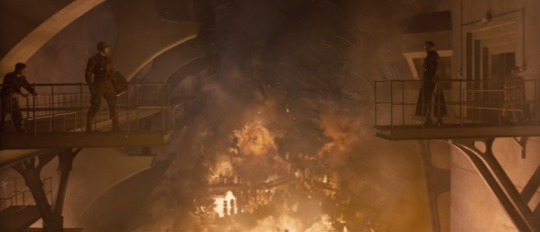
In this context, the weight of the war and the toll that it takes on the psyche of those suffering through it is carried almost exclusively by Bucky Barnes, who emerges from the unseen tortures of a Hydra work camp changed, his buoyant enthusiasm from the beginning of the film subdued, locked up behind the shattered look in his eyes and the fragile way he carries himself, determined to see this thing through to the end so that he can fall apart later, if he makes it that far (he doesn’t). Fandom has made much of Sebastian Stan’s understated performance, and with good reason: despite a minimal number of scenes there is a richness of detail in Bucky’s character, and as the emotional sinking ground for tragedy - both as the personification of the war’s devastation, and as a personal loss for Steve Rogers - Bucky’s narrative importance belies the amount of time dedicated to him in-text. Fandom has also made a strong point - with which I agree entirely and for which I will not pretend to take unique credit for noticing - that despite expectation, Bucky’s archetypal function in the film is not as the Hero’s Sidekick; he is, in actuality, fulfilling the cliche of the Love Interest, not in competition with Peggy Carter but instead of; Peggy, likewise, is not an archetypal Love Interest at all, because she’s the Hero’s Sidekick.
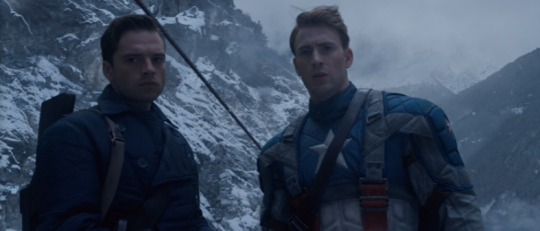
I am entirely of the opinion that this is an essential part of what makes Peggy - the sole named female character in town - work out so well, against the odds. As Steve’s sidekick, Peggy’s primary functions are to support him and give him advice; the sidekick is traditionally a rational role, someone who keeps the hero grounded and helps them to make the right choices, especially when they are emotionally conflicted. The Love Interest compels the hero’s emotions, sometimes (often) framed as driving them to acts of recklessness, to joyous heights, and depressive lows. Bucky is Steve’s damsel in distress; Steve is compelled to act when he learns that Bucky has been captured by the enemy, action which is tempered and assisted by Peggy’s influence and which ultimately brings Captain America out of propaganda mode to practice what he has preached, and be the soldier Steve always hoped to be. When Bucky falls, Peggy is there to talk to Steve, as a friend, and help him stop wallowing and concentrate his grief into the resolve which carries him through the climactic confrontations of the film’s final act. I’m not going to argue that Steve wanted to join the army just to be with Bucky (presumably that was a factor to some extent, but to call it the primary motivator would be to ignore the value set which made Steve into Captain America in the first place), nor that he was willing to sacrifice himself in the end because Bucky was gone (Steve’s mourning for Bucky certainly played a role in his mental state at the time, but ultimately, bringing down the Valkyrie was a practical choice, not an emotional one), but undeniably, Bucky was either integrally or tangentially attached to all of Steve’s major decisions across the film, as is common for a Love Interest, whereas Peggy consistently filled a support-and-guidance role, as any good sidekick should.
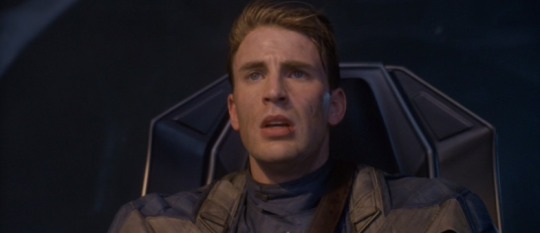
This is not to imply, by any measure, that Peggy can’t or shouldn’t be seen as a viable (lower case) love interest (or that Bucky’s time as a hero’s sidekick somehow doesn’t count as what it is); actually, I think that both character’s relationships with Steve benefit from being framed in this switched fashion. Bucky’s lifelong friendship with Steve comes across stronger and more meaningful due to the emotional pitch, allowing it to resonate as something deeply significant to Steve despite the limited exposure we have to it in action - extra important considering that Bucky is also fulfilling that sacrificial-character role. For Peggy, the fact that she is presented as a love interest but coded as a Hero’s Sidekick is even more important in its effect: since she is the only woman around, we have been taught by approximately All Media Ever to perceive her as the Love Interest from the second she steps on screen, and with that perception we are also encouraged to devalue her character as essentially existing for no other purpose than to be an attractive female prize for the Manly Male Hero to win by story’s end. By reinforcing Peggy as a friend to Steve, we subvert the expectation that she has no real function and/or that her personality is irrelevant, because narrative coding has taught us that sidekicks (almost exclusively male) matter, they have things to say and their influence on the hero is meaningful. Whether they are stalwart sidekicks, or bumbling fools, comedic, or secretly-insidious, a sidekick should be noted, because they’re a lot more likely to have something plot-relevant going on than a boring old Love Interest. Being presented as a helpful, sympathetic presence in Steve’s life who also Has Her Own Shit Going On allows Peggy to meet Steve on more even ground, and her interactions with him are not built around being romantically or sexually available: by having a working relationship built on a foundation of understanding friendship rather than attractive chemistry, the development of feelings between the characters comes across more as extraneous and organic, rather than a prescribed cliche. It still is a prescribed cliche, but it’s not one that compels Steve to do dumb stuff or that undermines Peggy’s relevance as a person in her own right, and that makes it a much more palatable romance than what we usually get.

This is also why that idiotic ~jealousy~ contrivance I flagged earlier is so out of place - I mean, it’s out of place because it’s idiotic, it has no impact on the story in any way and its an insult to the characters and I don’t know why it exists or why they kept it in the final cut of the film because it’s asinine rubbish, but it’s also out of place because it approaches Peggy as a Love Interest, scorned and emotionally lashing out, an attempt to generate Love Interest drama where it has no place in the movie, for the characters as the people that they are, with the established dynamic that they have, or in the context of their situation. Throwing a misunderstanding and some hurt feelings on top of a relationship which has worked refreshingly well thus far because of the honest and open conversations the characters have shared is utterly tone-deaf, and it’s one black mark on what is otherwise a shockingly strong and tonally-consistent film. She may be all alone in the movie, but I will happily argue that Peggy is the best, most-rounded female character in the MCU at this early stage, and she’s playing across from an eminently worthy leading man in Chris Evans’ charmingly-sincere Steve Rogers. The supporting cast is there - Seb Stan, of course, but also Stanley Tucci! Tommy Lee Jones! HUGO WEAVING! - being wonderful and engaging across the board, and there are no weak links (except Natalie Dormer, but that’s not her fault, and at least the misstep is brief and POINTLESS so that it doesn’t taint the rest of the film). Captain America: The First Avenger may not be absolutely perfect - nothing is - but it is a great ride, sometimes surprisingly nuanced, sometimes intriguingly subversive even while it plays straight with the expectations of its genre. I went into my first viewing of the film just hoping it wouldn’t make me mad, and I gotta tell ya: I ain’t mad at all. As far as I’m concerned, this is the platonic ideal of superhero films.

#Captain America: The First Avenger#MCU#Marvel Cinematic Universe#Bechdel Test#female representation
17 notes
·
View notes
Text
36 Hours in Olympic National Park (& Bainbridge Island!)

The Hoh Rainforest - Hall of Mosses trail
Summary
Olympic National Park is a wonderful place for a weekend getaway from Seattle. We experienced 3 different types of nature – temperate rainforest; cold, stark, jaw-dropping rocky beaches; and gorgeous alpine areas. There are plenty of short and beautiful trails that can make for a relaxing, not-too-strenuous visit, and the beautiful town of Port Angeles is an exceptionally comfortable place to stay overnight with delicious food and plenty of lodging options. If you’d like to do something more intensive, there also seem to be some neat, longer trails that are perfect for a multi-day backpacking adventure. While we didn’t find Olympic to be mind-blowing in the same way as, say, Glacier or Grand Canyon, it is incomparably unique and was one of our favorite weekends of the entire year.

Hurricane Hill
What to do
Olympic National Park can be accessed by a circular road, similar to Yellowstone. The park is mostly on the inside of the circle, so you’ll drive into key attractions and then back out to get back onto the road. There are also beaches that are on the exterior of the circle, along the Pacific coast.
We think our perfect return trip to Olympic would be two nights, as follows:
Friday afternoon: Drive 2.5-3 hours from Seattle to spend the night at Kalaloch Lodge (a national park-operated lodge on the beach)
Saturday: Explore the park’s coastal beaches and the Hoh Rainforest; spend the night in Port Angeles (we thought Olympic Lodge was perfect)
Sunday: Explore the Hurricane Ridge area. If you have extra time, either hike to Marymere Falls or stop by Bainbridge Island on the return trip to Seattle

Ruby Beach
Here are the key places we enjoyed visiting:
(1) Beaches: We visited three of the most popular beaches: Kalaloch (pronounced cuh-LAY-lock), Ruby, and Rialto. Each one was unique and worth visiting.
a. At Kalaloch, we spent just a few minutes (10-20 min) to see the Tree of Life and walk around a short ways.
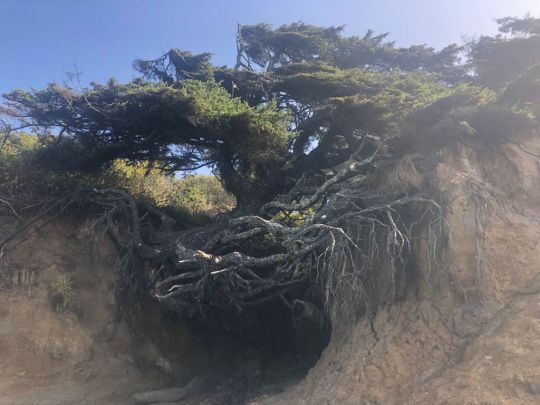
b. At Ruby, we spent a little more time walking down the path to the beach and seeing the pretty views of rock formations (20-30 min).

c. We spent the most time at Rialto (~90 min), where we walked to Hole in the Wall, a rock formation with a hole in it. Personally, I thought parts of the walk were very challenging and a bit unsafe for someone as balance-challenged as me, particularly walking over wet logs and rocks as it was raining. I probably would not do this walk in the rain, and definitely would not do it at high tide (be sure to check the tide tables in advance).

(2) Temperate rainforest: We visited the Hoh Rainforest, an incredibly lush area near the beaches. We enjoyed walking the short Hall of Mosses loop and the Spruce Nature Trail loop. Each was approximately 1 mile long, definitely easy, and had stunning views of the rainforest (think the scenery from Avatar).

(3) Alpine hiking: We loved the park’s well-known Hurricane Ridge area, just a 40-minute drive from Port Angeles. This is a high point in the park that has lovely views of mountains and trees. We hiked the Hurricane Hill trail (about a 1.5 mile drive past the visitor center), which climbs ~700 feet over 1.4 miles. It wasn’t easy, but the views were worth it. We had also hoped to hike the Sunrise Point trail up to Mount Angeles, but it was cloudy and a ranger told us we probably wouldn’t get great views in such weather, so we didn’t think the ~2,500 feet of elevation gain would be worth it.
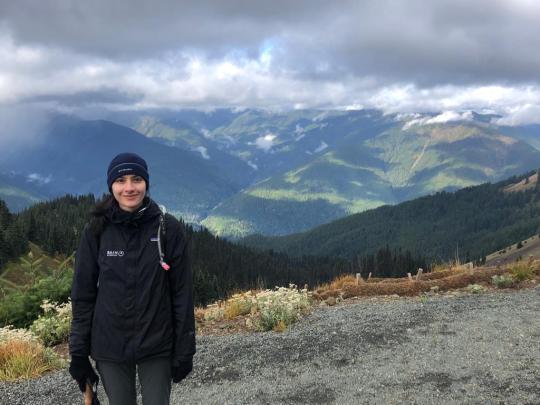
We didn’t get a chance to see a couple other areas we heard great things about. These may be worth looking into for a trip to Olympic National Park:
Shi Shi Beach (closed due to COVID-19)
Sol Duc Valley, which has a popular 1.6 mile roundtrip, easy hike to Sol Duc Falls and a popular backpacking trail (permit required)
Lake Crescent hikes to Marymere Falls (2 miles, easy) or Storm King (very difficult, nice view of the Lake)
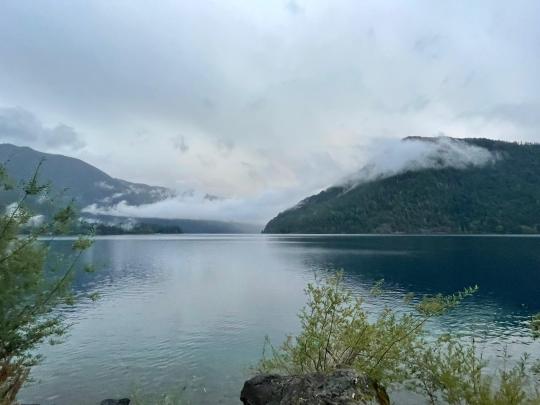
Where to stay: We stayed at the Olympic Lodge in Port Angeles. It was exceptional – clean, amazing customer service, large room with mini-fridge and microwave, and good continental breakfast included.
What to eat: We really enjoyed both meals we had in Port Angeles – Sabai Thai for excellent Thai curries and great service, and New Day Eatery for delicious vegetarian options like a tofu bahn mi and carrot cake smoothie. Overall, we were pleasantly surprised by how exceptionally friendly the customer service was everywhere we want in Port Angeles – even the cashier at the gas station struck up a conversation while we refueled our car!
Note: Street parking in downtown Port Angeles (for New Day Eatery) was fairly easy to find on a Sunday at lunchtime, and was free. We anticipate it is much more crowded when the ferry is running from Victoria (we learned it has been stopped for over a year due to the pandemic).
Bainbridge Island Pit Stop
Bainbridge Island is a bit of a drive from Seattle (if you don’t take the ferry), but it happened to be right along the way as we drove from Port Angeles back to Seattle on Sunday. We loved our visit and can highly recommend our afternoon itinerary:
(1) Visit the Bloedel Reserve: This is a beautifully manicured garden that is full of quaint surprises like cute little bridges and seemingly hidden reflecting pools. We spent about an hour there, walking along the 2-mile roundtrip path and discovering new botanical treats. Cost is $17 per adult, or free with American Horticultural Society reciprocal admission program -- just call in advance to reserve tickets. Parking is free.


(2) Visit the Japanese American Exclusion Memorial: This is a touching memorial to ordinary Japanese Americans who were deported from Bainbridge Island during WWII to be interned at concentration camps in the United States. Given that this violation of constitutional rights impacted 120,000 Japanese Americans during WWII, we couldn’t believe this was the first time we had been to such a memorial in the U.S. We spent about 15 minutes there and it was a wonderful stop. This visit is free.

(3) Walk around downtown Winslow, the main city on Bainbridge Island. We walked the ~2 mile Western Waterfront Loop; to our surprise, this well-marked path took us not just through commercial and park areas but also right in front of gorgeous homes on the waterfront. It very much felt like a European approach to making beautiful places part of the public domain rather than hidden behind private fences to those who can afford to purchase such properties. Note: We found plenty of free 2-hour parking around downtown when we visited on a Sunday early evening.

0 notes
Link
Items called “kimono” are having a moment in the fashion world. But as guest blogger Emi Ito points out, this trend revolves around appropriation and erasure of histories that are both deeply personal and extremely political.
The misuse and appropriation of the kimono seems ubiquitous these days. And the term is often used to describe things that are decidedly not kimonos, including jackets, coats, sweaters, tops, and jumpsuits. Since these items hardly resemble an actual kimono, one can only surmise that the kimono label is being used to invoke “exotic” Japan as a marketing tactic.
Adding insult to injury, these garments are typically not modeled by people of Japanese heritage, but by thin white models. This trend perpetuates white standards of beauty and erases the ties these clothing items have to the actual people that “inspire” them. All of these seemingly small but meaningful choices made by fashion makers and brands capitalize on racist stereotypes, erasing Japanese American history and Japanese American people. While the intention may have been benign, the impact is not.
Of course this Orientalist love affair with the kimono is nothing new. Since the late 1800’s, the cultural appropriation of the kimono in fashion has had a long and complicated history. Monet’s La Japonaise, The Mikado, and Katy Perry’s “geisha” look, are just a few of the many examples of the West’s fascination with all things Japanese.
But contrary to what Orientalist art and contemporary brands might have you believe, kimonos are not just clothes. They are garments worn for celebrations, sacred ceremonies, and life’s milestones. They are part of our family stories, which for some of us, are the stories of what was left behind and the people who are no longer with us.
My kimonos have been folded and tucked around the bodies of my great grandmother, grandmother, aunt, and mother. They are a part of our family’s heritage and a textured history of my matrilineal line. One day I will pass these pieces down to my own daughter so that she too can wear a garment sewn by her grandmother’s hands. These familial and cultural items have deep, even sacred significance: I wrap my ancestors around me when I wind and cinch my obi about my waist.
The fact that I have a collection of my family’s garments is a privilege. My family does not have the historical trauma of being incarcerated during World War II because my mother immigrated to the US in the 1960s. We did not share the fate of 120,000 Japanese Americans who were charged with the “crime” of looking like the enemy and forced to take only what could be carried, then locked behind barbed wire fences for years.
My family did not have to decide between western style everyday clothes, family necessities, and precious cultural pieces like our kimono, scrolls, koto, shamisen, and lacquer pieces. The fact that some families did choose to bring kimonos with them shows what great sentimental and cultural value they hold. So many tangible pieces of family legacies were lost and even stolen because not every family was able to bring items like their traditional garments into the concentration camps. In some cases, families even burned their heirlooms out of fear that they would be seen as incriminating evidence of an imagined collusion with Japan.
Even though my family was not incarcerated, I experienced the aftermath of racism against people of Japanese heritage. I was called racist names, taunted, made to feel less than and othered. Like so many Japanese Americans, I internalized the societal messages that assimilation would be best.
Especially during the early part of WWII, those messages were explicitly taught in the camps and in resettlement programs.* English language lessons and citizenship classes, patriotic exercises, the sponsorship of boy scout troops, and required seminars on “How to Behave in the Outside World” were all part of a concerted effort to strip Japanese Americans of their cultural identities under the guise of “Americanization.” The crushing pressure of assimilation not only took away the Japanese language from many in subsequent future generations, but also weakened cultural ties, and the ability to pass down family heirlooms such as kimonos.
To invoke the name of a deeply significant cultural item, the kimono, without the consideration of how Japanese Americans were made to feel inferior and in many cases forced to assimilate, is hurtful and renders the history of Japanese Americans invisible.
We are witnessing a moment when history seems to be repeating itself: children and families seeking asylum are being incarcerated and separated. They too have only what they were able to carry. These stories are all too familiar to Japanese Americans. We are being told that they are the enemy we need to keep at bay by building a wall.
The stakes are high and there is much for Japanese Americans to speak out about. In light of the stark realities we are living in, cultural appropriation may feel insignificant. I would like to offer that there is room for speaking out about the large and the little injustices that hurt our hearts. I would like to offer that when we start speaking up about the little things, it gets easier to speak up about the big things.
As someone who enjoys fashion, especially the rise of ethical, sustainable, and slow fashion, where small brands feel more approachable and interested in a genuine dialogue, I worked up the courage to speak out. For garments that seem to be more inspired by the haori, I asked makers to use haori instead of kimono. I also asked some makers to change the name of their garment to duster or coat if the item did not resemble a kimono. So far several brands have made the changes including two sewing pattern makers. These tiny wins give me hope at a time when hope feels rare and far off.
I wear my kimonos to remember. When I wear them, I remember my foremothers and invoke their strength, love, and resilience. Let us be mindful of how we interact with and are inspired by cultures that are not our own. Let us truly appreciate and not appropriate, by slowing down long enough to deeply consider the unique histories and the people who wear their cultural garments to communicate pride in their heritage; who wear their textured legacies wrapped around them to remember what may have been lost and what is their right to reclaim.
#cultural appropriation#kimono#japanese american#history#racism#discrimination#Densho#japanese in japan#japanese diaspora#japanese internment
60 notes
·
View notes